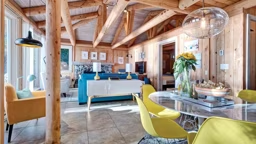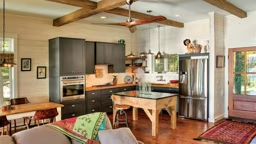
Cabins are some of the most eco-friendly houses, so you’re already one step ahead of most people. However, living in a log or timber cabin in the country isn’t enough to call yourself an environmentally conscious renter or homeowner. You still need to make daily efforts to ensure your cabin remains sustainable.
Following these seven steps will help you respect nature with an environmentally conscious lifestyle while enjoying all the comforts of cabin living.
1. Use Alternative Energy Sources
Since they’re usually in secluded areas, cabins can access more alternative energy sources than most other houses. You can install as many solar panels as you please and use hydroelectric power if you live near water. These methods are must-haves for cabins that aren’t connected to the local power grid.
Solar panels can be expensive to install, but most homeowners see a full return on their investment in just a few years because of how much money they save on utility bills. Plus, they will increase the cabin’s resale value because they will make the property more attractive to eco-conscious buyers.
If you install solar panels in the near future, you will also benefit from a 30% tax credit thanks to the Inflation Reduction Act. Cabins are expensive to maintain, so you should take advantage of tax exemptions wherever possible.
Hydroelectric power is a lesser-known option but has even greater energy-saving potential. You can rely on the natural water cycle to create an endless stream of energy. The water flows through a dam or water mill, spinning a turbine that generates electricity.
2. Install Energy-Efficient Appliances
You should also use smaller home appliances with energy-efficient features to reduce your cabin’s ecological footprint. Start by installing these essentials:
- Electronics with solar-powered batteries
- Light fixtures with LED and CFL bulbs
- Energy Star HVAC system
- Smart thermostat for temperature control
- Low-flow faucets, toilets and showerheads
Every green appliance you add multiplies the amount of energy or water your cabin saves and reduces your bills. When you use less, nature gets more — and so does your wallet.
Reduce Waste
Cutting back on waste — particularly food — should be one of your main goals with eco-friendly cabin living. The United States wastes 30%-40% of its food supply every year due to avoidable things, such as not finishing meals or failing to cook properly.
You also need to be careful not to burn through napkins, plastic utensils and other disposable items. Only 43.1% of nondurable paper products actually make it to the recycling plant. Using more durable and sustainable options is the better course. It’s only fitting to use natural wooden utensils or silverware at a cabin instead of disposables.
Start a Food Garden
Starting a food garden is another great way to reduce waste while making your cabin more self-sufficient. Grow low-maintenance fruits and vegetables like potatoes, beets, kale and berries until you become more confident in your gardening skills. Also, ensure you’re using the right soil type and know each plant’s climate preferences.
Gardens benefit the environment in many ways. They create more biodiversity, keep the soil on your property fertile and act as highly effective air purifiers by filtering carbon dioxide into oxygen and water. They also absorb chemicals and heavy metals from the ground, helping other plants thrive nearby.
Seal Your Cabin
Log cabins are more prone to drafts than most other houses. Gaps in the lumber can grow over time, allowing air to seep through and offset your HVAC system’s hard work. That’s why you need to perform routine staining and sealing. This minor repair will also create a rustic look that many cabin owners strive for.
You should add heavier curtains to trap the warm or cold air inside, depending on the time of year. Air seeps through windows all the time, even if they claim to have airtight seals. Just ensure the curtains and other objects don’t obstruct your vents so the air can move freely around the house.
Install a Water Harvesting System
Many cabins have natural water sources, but if yours doesn’t have such a luxury, you can always install a rainwater harvesting system. They capture rain and snowmelt, pump it through a purification system and send the clean water back into your piping. Recycled water can provide up to 50% of your cabin’s water supply, slashing your utility bills in the process.
Use Campfires Responsibly
Most cabin owners love campfires. When you have nothing else to do, you can always start a cozy fire and cook over it or relax with friends. However, many people act irresponsibly around them. They throw anything they want into the fire, including plastics that release toxic smoke into the air. Everyone around the fire breathes in the smoke, and it eventually reaches the soil and water sources.
You need to set strict rules around the campfire. Don’t throw anything in the flames besides dead or dying wood. Keep the green stuff out to avoid creating too much smoke or accidentally burning a poisonous plant. Garbage is a huge no-no. Always have a few buckets of water on standby in case the fire gets out of control.
Leave No Trace
Any time you do an outdoor activity around your cabin, you should strive to leave no trace. Leave the environment exactly as you found it. Clean up after yourself and don’t do any needless damage, such as breaking tree branches or disrupting wildlife. You might have the deed to the property, but the animals have equal ownership of the land and deserve the same respect you would give to any other neighbor.
Set the Example for Other Cabin Owners
Moving to a cabin in the country is a great step toward eco-friendly living, but it’s not enough. You need to set an example for others by practicing these tips. Saving energy and supporting local animal and plant life should always be your top priorities. Some of these changes will take lots of effort to implement, but time seems to slow down when you live in a cabin. Use it wisely.










